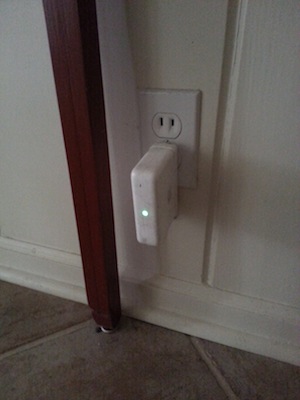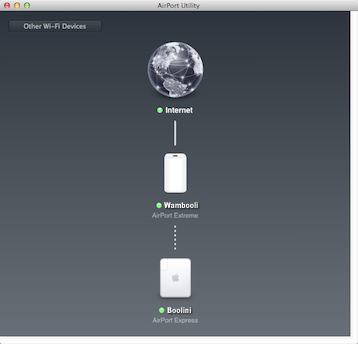Most people set up a home network that includes a Wi-Fi base station. Smart move: Given today’s portable gizmos, it makes sense for them all to gang up on the local network and eschew those mobile data surcharges.
When the Wi-Fi network doesn’t reach everywhere in the house, extend it with a Wi-Fi extender.
First things first: Always ensure that you’re network is using the latest, bestest Wi-Fi technology. I just replaced my old router about a year ago, and after the initial ordeal, it’s been working fantastically.
The latest router technology uses the 802.11a/b/g/n standard. If your Wi-Fi hub doesn’t support that standard, or if it’s at least 3 years old, consider an upgrade. Yes, a new router costs more money, but it’s worth it over the frustration you’ll save.
After you get the router setup, you’ll notice that it may not reach every room in the house.
True: The range on a Wi-Fi signal is up to 300 feet. I’m sure that’s in a vacuum with no visible obstacles in any direction. In the real world, the 300 foot limit is hampered by everyday objects, such as walls.
For example, I can stand in my bedroom doorway and get a Wi-Fi signal on my phone, but if I move away from the (open) door, the signal vanishes.
To solve the problem, I bought a Wi-Fi extender.
The extender is like another Wi-Fi hub, but it’s merely designed to repeat the signal, not generate a new one. In fact, you could use an old Wi-Fi router as a repeater, but I strongly recommend getting something customized for the job.
Because I’m using Apple’s AirPort Extreme as my Wi-Fi hub (and it doesn’t mind the PCs or Androids), I purchased Apple’s AirPort Express as my extender.
The extender is easy to set up: Plug it into a wall socket, as shown in Figure 1.

Figure 1. My Apple AirPort Express, used as a Wi-Fi extender.
It’s best to find a location where the base station can still broadcast. The location shown in Figure 1 is only about 30 feet from the base station (the AirPort Extreme), but the signal drops because of walls and kitchen appliances.
After you plug in the extender — and it requires no additional cables — you need to use your Wi-Fi router’s configuration screen to extend the network: Set up the extender’s password and such, then use the router utility or its webpage to extend the network.
In Figure 2 you see the AirPort Utility, which I’ve configured to extend my network, Imperial Wambooli, to the AirPort Express.

Figure 2. The Wi-Fi network, extended by using the AirPort Express.
With the extender in place, the signal in my house is boosted and covers the entire floor plan. As I have a rancher-style house, and the base station in the office is at one end, the extension ensures that the Wi-Fi signal goes everywhere — even though the bedroom door.


Ive been in the market for getting a Note 3, and reading Amazon reviews I noticed someone who has no cable or internet in their house, but does everything on their Note 3 using unlimited 4G LTE. They watch all their tv hows on Netflix and Hulu, they hi-res screen renders webpages like a laptop so they can do all their internet browsing. So it looks like mobile wireless has the potential to knock out wifi.
Comment by BradC — June 10, 2014 @ 2:58 pm
You may be correct, especially if the per-month charge for the 4G LTE is less than the per-month charge for the service the Wi-Fi is connected to.
Comment by admin — June 10, 2014 @ 5:08 pm